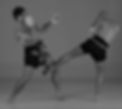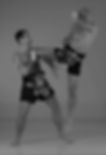M U A Y T H A I F E V E R Muay Thai Gym, Chiang Mai, Thailand
Traditional Muay Thai
Muay Thai, deeply rooted in tradition and steeped in centuries-old practices, embodies the essence of Thailand's cultural heritage. Its traditional techniques, honed over millennia, intertwine with the country's rich spiritualism and the guiding principles of Buddhism. This ancient martial art is not merely a sport but a profound reflection of Thailand's enduring traditions and spiritual beliefs.


Wai Kru in Muay Thai
The Wai Kru (Prayer to the teacher) tradition is seen at Muay Thai stadiums across the world. It is usually the first part of the ritual dance seen prior to Muay thai fight commencing. The fighters are usually seated and each gym, Master, area and individual has a signature move which are used to design a fighters Wai Kru routine. It nearly always involves a fighter kneeling and bowing 3 times in an elaborate manor.
Ram Muay in Muay Thai
The Ram Muay (Boxing Dance) is the second part of the pre fight ritual where the fighters move around the ring in an elegant demonstration of poise and balance. The Ram Muay also varies from fighter to fighter, gym to gym, area to area etc but generally involves moving in a similar way to all four directions of the boxing ring.


Pre Fight Ritual in Muay Thai
Before the Wai Kru and Ram Muay take place the fighter has already performed some subtle but important rituals. Placing the Mongkol on the fighter, giving the fighter water, prayers at the foot of the ring, entrance into the ring and walking around the ring offering a short prayer to each corner post or direction are all executed in a certain way which is steeped in tradition.
Mongkol
Also pronounced Mongkon the Mongkol is an auspicious headband worn by Muay Thai Fighters during the pre fight ritual, Wai Kru & Ram Muay
. Ancient Thai warriors would prepare for battle by saying prayers and invoking spirits to protect them in warfare. They would write down these incantations on a strip of cloth and wear it around their heads during battle.
The camps Monkol is a treasured article and will always be hung up high and taken care of according to age old traditions. It is blessed by monks and may even have hair / bones / fingernails etc of past famous fighters who represented the camp. They are often adorned with amulets that are considered powerful and it is hoped that they will protect the fighter.
The Monkol is placed on the fighters head prior to entering the ring and is worn during the Wai Kru / Ram Muay. The Monkol is removed just before the fight by the head trainer or camp owner who will chant a prayer as he removes the Mongkol.


Pra Jiad
Pra Jiad or Prachet are armbands that serve a similar purpose as the Mongkol. In ancient times a warrior would often take some fabric from his mothers dress and wrap it around his arms hoping to be successful in battle.
Pra Jiad are worn by the fighter during the fight, they are not removed with the Mongkol pre fight.
In recent years the Pra Jiad has been employed as a ranking system to reward practitioners of Muay Thai who are not pursuing a fight career. There are usually 15 grades and each is represented by a different couloir combination.
Mae Mai - Major Techniques
The "Mae Mai" (Literally meaning "Mother Techniques") are the 15 major techniques that form the basis of the Muay Thai system. In the past these techniques would be the first thing a new student of Muay Thai would have to study and master. It is fair to stay that the sport has evolved past these techniques now but there is still an historic role for the classics to play.
It is no longer necessary to know these techniques in order to become an accomplished Muay Thai fighter but it is considered important for advanced students and Instructors to understand the classics in order to appreciate the rich history of Muay Thai as an art form.
Hidden within the classics, however, are all of the import strikes and movements that are seen regularly in the modern Muay Thai stadiums.
Practical application of the classics is free to interpretation and there are many different ways in which each of the 15 techniques can be employed.




